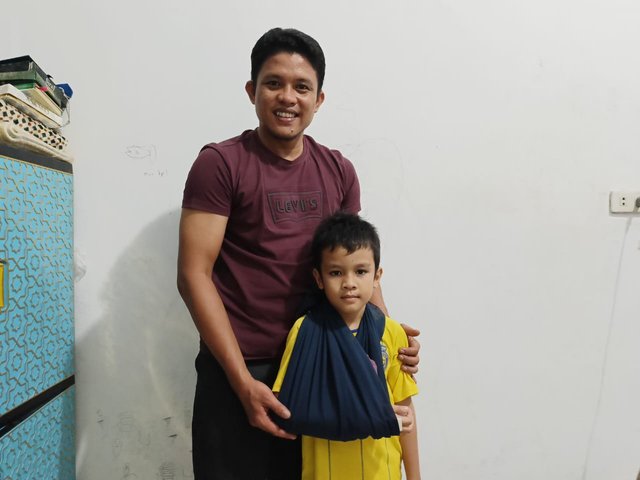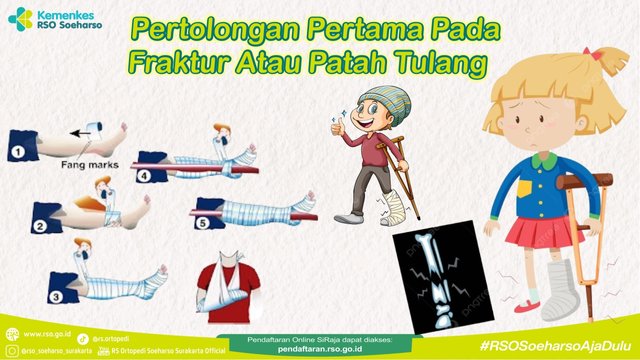
Assalamu'alaikum warahmatullahi wabarakatuh.
I wish all of us to always be in a healthy and happy state, and of course to avoid things that endanger our daily activities.
This is my first attempt to learn on the teaching team of Dr @abdu.navi03 and Dr @huzaifanaveed1, the theme of this fourth week is comprehensive First Aid for various types of fractures. It is interesting for me to know and try to participate to learn from what has been described in the contest post.
Because I wanted to learn about this useful thing, I also read and searched for years about this week's theme. The more references, of course, increase my knowledge of comprehensive First Aid for various types of fractures, and this is certainly good news for me so that I can later use and apply it in certain conditions and situations that require me to deal with the situation.
Reading carefully, I will immediately start learning in Week 4. Hopefully I can do well. Let's start one by one tasks that must be answered and practiced.
| Q1: Apply a sling on the arm and a splint on the finger of a sibling, child, or peer. Attach a picture of the application and explain the procedure in detail, highlighting key points for immobilization and stabilization. |
|---|
Before starting, I illustrated this condition came suddenly and with improvised tools I did it.
The information I got from the contest post is that there are two types of fractures that can occur and be experienced by someone.
- First is a simple fracture (closed fracture).
- The second is a complex fracture (open fracture).
The illustration of the case that I will try is a type of fracture in which the bone breaks but does not penetrate the skin or is called a simple fracture (closed fracture), or more precisely greenstick fracture (bone bent due to external force). From the reading contained in the contest post, I can conclude that to deal with cases like this, I can do it in the following ways.
1️⃣ First. (Choose the right splint material)
Choose materials that are available but must be appropriate for use. Furthermore, I make sure that the victim remains in a calm condition, this is needed so that there is no panic experienced by the victim and also provides peace for the medical team to deal with the condition of the injury.


2️⃣ Second.
I will roll the cloth tightly until it forms a cylindrical shape, but first, make sure which part should be handled, and then I will use a splint replacement cloth as a tool to immobilize broken bones or injuries in the patient.


3️⃣ Third.
In the next step, I'm going to carefully attach the improvised splint from the available material and tie it up, and I make sure the ballet covers the entire arm that has the fracture. as below picture :


4️⃣ Fourth.
The next step, I ensure circulation by checking the warmth and feeling in the fingers of the victim's hand. This is very necessary to see how accurately the splint is applied.

At this stage, the splint on the arm is installed properly and correctly, according to the steps I know.

5️⃣ Fifth.
I will make a sling from the materials at hand, in this case, the fabric that I have. Attach the sling to the arm and splint I learned from several articles I read, as part of the study, including on this contest post.
The process and steps of installing the Sling you can see in the photos of mine below. This is an illustrative photo.
 |  |
|---|


The installation of a sling on the arm and a splint on the finger has been completed. In the first task in this theme, I think I have completed it, hopefully, this step is correct, if there is confusion may be input for me.
| Q2: Research the process of helmet extraction in the context of head and neck injuries, and explain why it is important to avoid removing the helmet immediately in the case of suspected spinal injuries. Include the steps for safe helmet removal if necessary. |
|---|
For the second part of this question, I honestly don't know to practice this. But to do this, you have to go through a careful process because it is related to the spine, this requires great care to do it.
At least we should pay attention to the main procedures, for example:
- Perform Immobilization. (minimizes movement).
- **Medical Stabilization. (Do not make it worse for the person who suffers from it).
- Position of the victim.
- Perform spinal decompression or stabilization, as a way of preventing bleeding or medical follow-up.
- And finally the recovery process.
| Q3: How is C-spine stabilization done? Explain the procedure in detail, ensuring you include when and how to use head blocks or manual stabilization. Attach a photo or video of yourself demonstrating proper C-spine stabilization techniques. |
|---|
To explain this third task, I am guided by the description of the teaching team. These steps include :
- Support the head and neck, or contact the nearest health service.
- Instruct to remain silent, this is important so as not to experience other problems related to the injury experienced, while keeping the victim calm.
- Assessing other injuries, can be done by checking the ABC (Airway, Breathing, Circulation) without moving the head/neck. This is on the lessons I got from the teaching team post.
- Maintain Stabilization.
- Secure on the spine board, based on this information need more than 4 people to perform this.
- Constantly monitor and reassure.
- I want to take off the helmet.
The following are some parts of the photo as an illustration,these photos are my own.
 |  |
|---|
 |  |
|---|
| Q4: Consider you encounter an unconscious person with a compound fracture on the arm, massive bleeding, no pulse at the distal radius, and restricted breathing. How will you prioritize and manage the situation? Describe each step in detail, including how you would control bleeding, stabilize the fracture, and address the breathing issue. |
|---|
So far I have not experienced such conditions, but it is not impossible that unexpected things can happen in certain conditions and situations. If indeed it must be faced with the circumstances mentioned in this 4th task, then I will do some things that may be by the learning I get in the contest post.
- I make sure the surrounding conditions remain safe, to avoid more severe injuries that will be experienced by the victim.
- If it were possible to contact the medical authorities, maybe that's the thing I would do. I also have to make sure the victim is conscious or not first, this is a little complicated to understand.
- If circumstances do not support me, maybe I will take steps to suppress the source of bleeding that occurs. This can be done with the help of a cloth to do so so that the bleeding can at least be stopped.
- If circumstances and conditions permit, it is possible to perform fracture immobilization with the capabilities and knowledge that I have.
- Monitor the victim's condition afterwards, by re-ascertaining the pulse of the victim. If necessary, cardiac and pulmonary resuscitation steps may be done, it is important to know this.
- Surrender so that the medical team can help immediately.
| Q5: Create an infographic (visual illustration) on managing fractures. Your design should highlight key steps such as how to immobilize the injured limb, apply a splint, and stabilize the spine. Ensure the infographic is easy to understand and visually guides users through the process. |
|---|
infographic (visual illustration) about the handling of fractures I share with you, this image is sourced from the Directorate General of Health Services, the official Ministry of health of Indonesia.

Thus, so many posts of my participation on this occasion, it's nice to be able to read, try, and learn about the theme of this 4th-week contest. May what I publish be useful to myself, as well as to all who read it.
Before ending this post, I invite @radjasalman, @megaaulia, and @eliany, best regards to all of you.
| Period | 22 August to 22 November 2024 |
|---|---|
| Transfer to Vesting | 1,818.239 Steem |
| Cash Out | 0 Steem |
| Result | Club100 |
| CSI | 12.6 (0.00 % self, 76 upvotes, 62 accounts, last 7d) |

Student Name: @fantvwiki
Overall grade: 7.7
Plagiarism Check: Pass
AI Use: No
General Feedback: The student has shown good understanding of the course and has come up with a good explanation on how to manage fractures. Further details would have improved your assignment significantly.
Thank you.
Regards,
@huzaifanaveed1
Downvoting a post can decrease pending rewards and make it less visible. Common reasons:
Submit
Postingan yang perfect dan informatif.
Terimakasih sudah mengundang saya , sepertinya saya akan ikut berpartisipasi .
Sukses untuk anda 👍
Downvoting a post can decrease pending rewards and make it less visible. Common reasons:
Submit